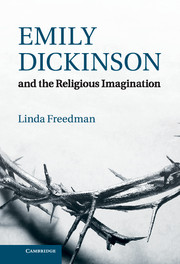Introduction: Dickinson and religion
Published online by Cambridge University Press: 07 September 2011
Summary
In 1862 Emily Dickinson was at the peak of her creative power. This was the time when many of her most interesting poems with broadly religious themes emerged, including her famous description in a letter to Thomas Wentworth Higginson of God as an ‘eclipse’ that her family worshipped each morning. Dickinson’s well-known ‘eclipse’ is a small example of her ambivalent feelings about religion and faith. An eclipse has a curious and dominating presence. In the early world, eclipses were worshipped because they inspired fear. Even today, on the rare occasions when an eclipse appears, it draws our curiosity and our wonder. This poet’s eclipse is both sarcastic and appreciative. Her sarcasm no doubt stemmed from a disregard for unquestioning faith. But her disregard was combined with a more equivocal appreciation of religion. That appreciation is the subject of this book.
The animating absence of Dickinson’s ‘eclipse’ gave James McIntosh the subject for his book Nimble Believing: Dickinson and the Unknown. This book is an important precursor to my work in several ways. I am in complete accord with his claim that ‘the unknown is not so much a subject she takes up as a condition of her poetic existence she perpetually comes up against’. This seems to me to be a wonderful way of expressing the vitality of Dickinson’s poetic texture and the paradox of her epistemic reaching enabled and halted by its own limitations. His emphasis on the variety of Dickinson’s religious tones and the influences of Puritan and liberal thought has also helped my study of her religious imagination. But McIntosh, like many excellent critics before him, returns in the end to the question of whether Dickinson really believed in God. Through her poetry he ascribes Dickinson a personal faith which encompasses (and partly relies upon) doubt, concluding that, for her, the unknown was the ground upon which one truly encountered God. So, his study assesses Dickinson’s poetry as an expression of faith.
- Type
- Chapter
- Information
- Emily Dickinson and the Religious Imagination , pp. 1 - 15Publisher: Cambridge University PressPrint publication year: 2011



